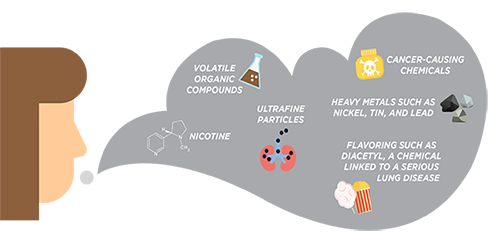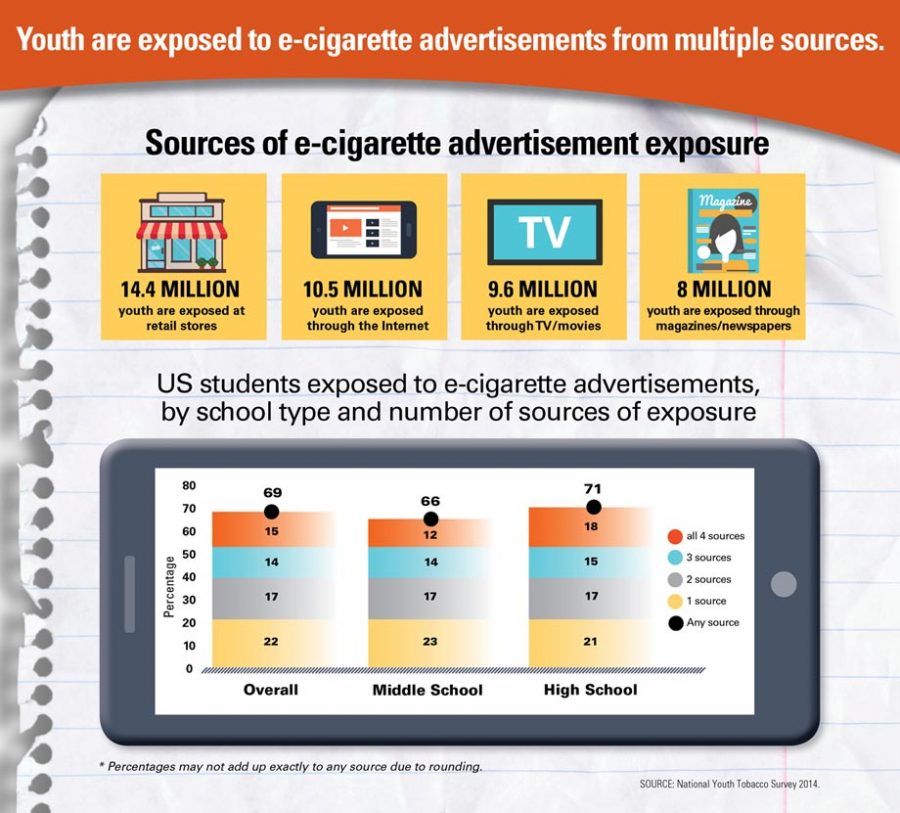Image Courtesy: Centers for Disease Control & Prevention
Infographic: Youth are exposed to e-cigarette advertisements from multiple sources.
OPINION: The Hyper-Modern Addiction of E-Cigarettes
December 13, 2018
E-Cigarettes, particularly the brand JUUL, have become a major problem in high schools and for high schoolers, and the FDA is intervening with new regulations.
Ending the Debate on JUULs

Centers for Disease Control & Prevention
The CDC has released this graphic to warn E-cig users of the dangerous toxins in their vapors.
Over the past year, a strawberry scented wave has washed over the halls of high schools across America and it is all thanks to the new trend of Juuling. The e-cigarette Juul has come under fire in recent weeks after a report by the FDA linked them to cancer, causing a large outcry as the vape had found its way into the hands of teenagers. According to an article by CNN , a recent report by the US Center for Disease Control & Prevention states that 11.3% of American high schoolers admit to owning a Juul, or, roughly 1 in 10. This has been a wake-up call, depicting how substantial the problem has grown while America turned a blind eye.
The shock became anger as many began claiming that Juul was directly targeting kids by advertising flavors like vanilla creme and fruit medley. This forced Juul to launch a new campaign stating the health risks of the e-cigarette and banning many of their more childish flavors. An article by The New York Times states, “The decision by the company is the most significant sign of retrenchment by an industry that set out to offer devices to help smokers quit but now shoulders blame for a new public health problem: nicotine addiction among nonsmoking teens.”
The kids are getting addicted to the nicotine inside the Juul’s, giving them the same deadly dependency as a cigarette smoker. The danger does not stop there, however. An article by the National Center for Health and Research states, “The impact on the developing brain is of great concern. Brain imaging studies of adolescents who began smoking at a young age had markedly reduced activity in the area critical for a person’s cognitive behavior and decision making.”
One cannot ignore the fact that Juul’s do serve as one of the best ways to help smokers quit cigarettes. Juul’s don’t have tobacco which is the main component of cigarettes and one of its most deadly factors, and they do have different levels of nicotine content to regulate intake, but here, the bad simply outweighs the good.
Though well-intentioned, these revelations surrounding Juul’s impact on America’s high schoolers has left no other option other than to shut down Juul Labs for good.
Children are getting exposed to nicotine too young and it’s wreaking havoc on their brains, leaving them desperate for their next Juul rip. They are buying Juul’s to fit in without realizing what they’re really putting in their body and what it really means for them in the long-run. Kids are slowly poisoning themselves with cool mint and berry blast and it’s officially time to ask, how long are we going to wait before we finally put the Juuling epidemic to rest?
It’s time for JUUL to face stronger regulations

A Juul e-cigarette resembles a long USB flash drive. It can be “recharged” with pods.
A young adult may appreciate the buzz and relaxation following the rip of a Juul. A concerned parent may fear for their child’s health upon reading the atrocious rumors regarding the company. A cigarette smoker might find themself dumbfounded in choosing the right path to quit. What they all have in common, is that the long term effects of the product are unknown.
“We believe that vaping can have a positive impact when used by smokers, and can have a negative impact when used by nonsmokers,” reads a statement on JUUL’s official website, “Our goal is to maximize the positive and reduce the negative.”
As the greatly successful company, JUUL, promises that its intentions are nothing but good, a number of medical professionals are beginning to sound the alarm, saying that the long term effects of JUULs on teenagers could be extremely harmful.
Publicly, JUUL argues that it was never intended for use by minors. The company says that its aim was to help cigarette smokers shift away from tobacco by using the much safer version of the vaping device. Critics however, say that JUUL may have intentionally marketed to teenagers to increase profits. Looking at advertising, it features models who appear to be very young and appeal to a younger audience. Some argue too that the vape itself has a modern look to it, almost like a flashdrive, which might also attract a younger and more tech-savvy teenage customer base. Finally, the product itself appeals to the tastes of a younger audience with flavors like mango, fruit medley, and cucumber. Whether intentionally or inadvertently, the use of JUULs have become considerably cool amongst young adults.
Medical experts are concerned. Recent studies indicate that JUUL delivers higher concentrations of nicotine than other e-cigarettes. Not only is nicotine highly addictive, but it is additionally extremely toxic to fetuses and is known to impair brain and lung development if used during adolescence. The amount of nicotine in one JUUL pod has shown to be equivalent to one pack of cigarettes. As studies show that teens sometimes use multiple pods in one sitting, they are able to unknowingly become exposed to dangerous levels of nicotine that can have immediate and long-term health consequences.
The ever-growing usage among teenagers has now reached near-epidemic proportions. It is time for the government to pass the same restrictive measures on JUUL and e-cigarettes as they have done with traditional tobacco products, such as where it can be sold, how the product is advertised, etc. It’s only with these aggressive preventative measures that we may be able to stem the tide of addiction, and the potential long term health effects that face the youth of America.
Cited Sources
“E-Cigarettes around 95% Less Harmful than Tobacco Estimates Landmark Review.” GOV.UK, GOV.UK, www.gov.uk/government/news/e-cigarettes-around-95-less-harmful-than-tobacco-estimates-landmark-review.
“The Smoking Alternative, Unlike Any E-Cigarette or Vape | JUUL.” JUUL | The Smoking Alternative, Unlike Any E-Cigarette or Vape, www.juul.com/.
“The Dangers of Juuling.” National Center for Health Research, 13 Aug. 2018, www.center4research.org/the-dangers-of-juuling/.
Hoffman, Jan. “The Price of Cool: A Teenager, a Juul and Nicotine Addiction.” The New York Times, The New York Times, 16 Nov. 2018, www.nytimes.com/2018/11/16/health/vaping-juul-teens-addiction-nicotine.html.
